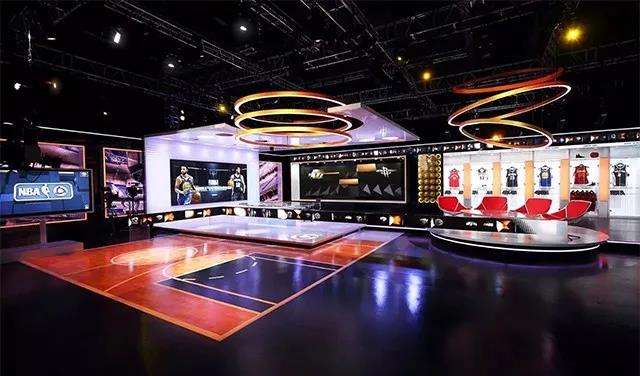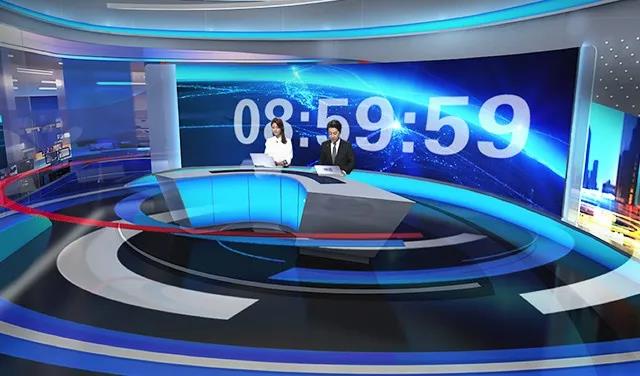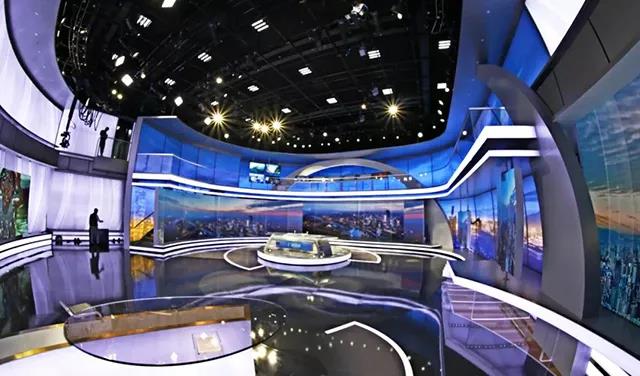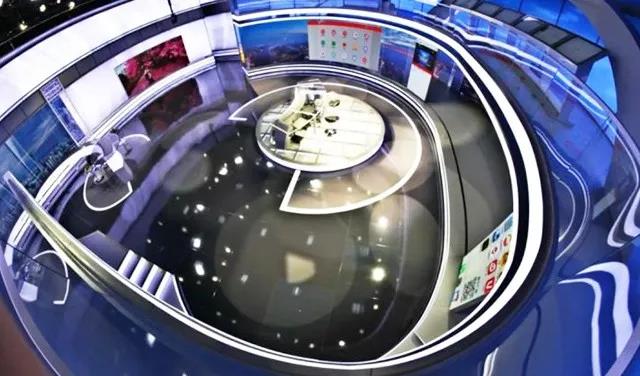With the rapid development of studio technology and continuous innovation of TV programs, all-media interactive panoramic studios (hereinafter referred to as “all-media studios”) have gradually become the mainstream and become an important form of studio development. Different from traditional studios, the omni-media studio is a studio program production and management model developed from multiple single studios. It integrates interior decoration design, stage lighting design, news anchor background large screen, multi-screen splicing, and Technical means and forms such as the aggregation and presentation of media content, the combined production technology of virtual and reality, and intelligent interactive control.
The lighting method of all-media studios is also very different from traditional studios. Traditional studios are styling a single character and creating an environment for a single area, while the lighting method of an all-media studio needs to be evenly distributed throughout the venue and a fixed rail plus slide rail rod control method for flexible lighting, paying more attention to the studio’s Theme expression of stage beauty, creation of program interactive atmosphere, etc.

1.Three-point lighting method highlights the character shape
The format of all-media studios is mainly live news programs. Live news programs are commonly used for single and double news broadcasts. The main purpose of lighting is to highlight the characters of single and double anchors. In the pre-lighting preparation process, the lighting engineer must fully communicate with the directors and producers of the relevant columns to understand the format and content of the program; understand the number, location and scheduling of the characters on the screen, as well as the position and position scheduling; pay attention to the anchor Master the type and number of lamps needed with the guests’ body type, hairstyle, clothing, age, skin color, etc., and determine the stage setting, anchor position and camera position. After that, combine these positions for overall lighting. News report programs usually have 1 to 2 people. The lighting of characters generally adopts the three-point lighting method, which is configured according to the light position structure of the main light, auxiliary light (also called auxiliary light), and backlight (also called contour light).

All-media studios have stronger media integration capabilities than traditional studios, and through functional expansion, they have stronger live broadcast and interactive capabilities. Based on the characteristics of multi-person interaction between the anchor and the guests in the interview program, there are multiple subjects on the shooting scene, there may also be interaction and screen connection between the scenic area and the scenic area, or there are multiple cameras and multiple cameras in the same scene In situations such as the subject, the light effect control of a single three-point lighting will become complicated and difficult. Therefore, when designing static or dynamic lighting for multiple people, it is also necessary to flexibly arrange the light positions on the basis of three-point or four-point lighting, according to the number of characters, location scheduling and modeling intentions.

Interview programs are often set for three or more people. The setting may be a real life or abstract scene, or it may be a combination of virtual and real background made with virtual implanted equipment. The photographed characters are in an arc for communication. Therefore, the design of the lamp position is usually distributed in an arc.
In interactive interview programs, the characters are required to be soft and uniform, and a large number of LED soft lights (panel lights) are needed for lighting. For the program shooting of multiple people in the same scene, the flat light method of circular lighting can enhance the interaction.
The lighting of the news program is mainly simple and natural, and the lighting design is based on the three-point lighting, striving to be soft and delicate, highlighting the skin color and details of the characters. On this basis, lamps can be added according to the number of people, scenery, and machine position scheduling, and the light positions can be arranged flexibly.
2.Annular lighting method enhances the interactive form of the program
All-media studios have stronger media integration capabilities than traditional studios, and through functional expansion, they have stronger live broadcast and interactive capabilities. Based on the characteristics of multi-person interaction between the anchor and the guests in the interview program, there are multiple subjects on the shooting scene, there may also be interaction and screen connection between the scenic area and the scenic area, or there are multiple cameras and multiple cameras in the same scene In situations such as the subject, the light effect control of a single three-point lighting will become complicated and difficult. Therefore, when designing static or dynamic lighting for multiple people, it is also necessary to flexibly arrange the light positions on the basis of three-point or four-point lighting, according to the number of characters, location scheduling and modeling intentions.

Interview programs are often set for three or more people. The setting may be a real life or abstract scene, or it may be a combination of virtual and real background made with virtual implanted equipment. The photographed characters are in an arc for communication. Therefore, the design of the lamp position is usually distributed in an arc.
In interactive interview programs, the characters are required to be soft and uniform, and a large number of LED soft lights (panel lights) are needed for lighting. For the program shooting of multiple people in the same scene, the flat light method of circular lighting can enhance the interaction.
The lighting of the news program is mainly simple and natural, and the lighting design is based on the three-point lighting, striving to be soft and delicate, highlighting the skin color and details of the characters. On this basis, lamps can be added according to the number of people, scenery, and machine position scheduling, and the light positions can be arranged flexibly.
3.Sub-regional lighting design for interactive programs in multiple scenic spots
The program production method of the all-media studio is not the “single fight” of a single studio, but the overall interaction and media elements between characters, between characters and background, between scenic spots and scenic spots, and even between indoor and outdoor. Show. Then, in the program production, there may be multiple camera positions and a large number of camera positions for scheduling shooting, and the setting of the lamp position and the light position must be carried out in accordance with these elements. After integrating the stage setting, anchor position, and camera position for overall lighting, the lamp position can basically be determined. However, in a specific scene, when there are character scheduling and lens scheduling requirements between the scenic area and the scenic area, it is still necessary to flexibly arrange the light positions in different areas. For example, the director asks the host to use one camera to exit the scene at the beginning of the program when the light is completely dark and only the stage light box is on, and then switch to another camera to enter the picture. The distance and angle of the two cameras are different. If it is larger, it is necessary to consider whether the light position is enough to connect the surface light effect of the anchor in the two screens, and the control of the light ratio also needs to be considered.

In the talk show, in addition to the oral broadcast, the anchor also has a lot of interactive content with the guests. The director’s scheduling of the shots will be great. There are close-up shots, panoramic shots, and even vertical or horizontal panoramic motion shots of anchors and guests. It is also necessary to flexibly arrange the lamp positions in different areas. Consider whether the lamp position, surface light quantity, light ratio and other factors can make the anchor and the guests different The angles of the picture are consistent and present a high-quality image.
4.The studio area and director create a “level” lighting of depth of field
Compared with traditional studios, omni-media studios not only have a studio recording area, but also a director room, and the director room is also equipped with a daily program editing and production area, with advanced and diverse functions, smooth and efficient workflow, and a strong sense of presence. Although the director room and the studio area belong to two different areas, they are in the same TV screen. The lighting engineer should comprehensively use the language of lighting to create the environment, highlighting the depth of field of the two areas.
After lighting the characters in the guest area, if the back-scene director only relies on office lighting and the self-luminous lighting of the editing computer screen, the shooting screen will appear dark, depressed, and without layers, and even the guests are wearing darker clothes At that time, the background and the characters “melted” into one. In order to solve this problem, the use of light must fit the stage style of the overall picture. A layer of matte blue film is laid on the soundproof glass in the guide room and studio area, and two soft LED flat lights are used to mark the area covered with the blue film. Backlight. Adjust the light ratio between the character and the background light, and at the same time, properly handle the “level” of the character and the background through the adjustment of the light position and light quality.
